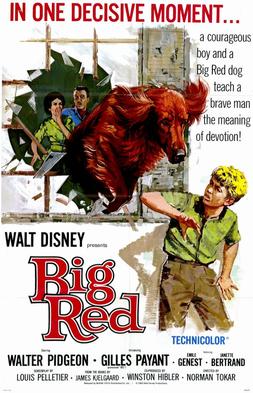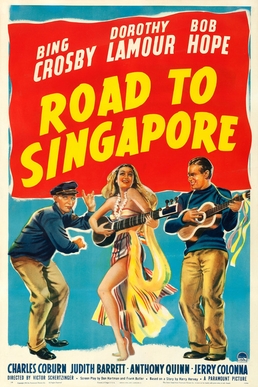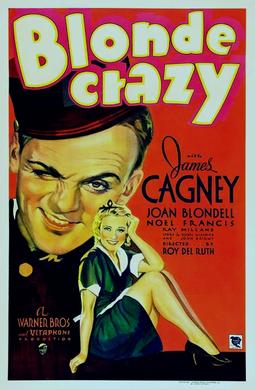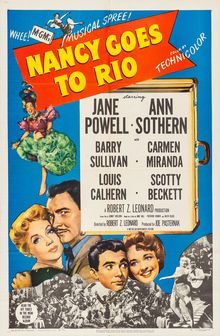
Road to Morocco is a 1942 American comedy film starring Bing Crosby, Bob Hope and Dorothy Lamour, and featuring Anthony Quinn and Dona Drake. Written by Frank Butler and Don Hartman and directed by David Butler, it’s the third of the "Road to ..." films. It was preceded by Road to Zanzibar (1941) and followed by Road to Utopia (1946). The story is about two fast-talking guys cast away on a desert shore and sold into slavery to a princess. In 1996, Road to Morocco was selected for preservation in the United States National Film Registry by the Library of Congress as being "culturally, historically, or aesthetically significant".

Big Red is a 1962 adventure film from Walt Disney Productions. Based on a 1945 novel by American author Jim Kjelgaard and adapted to the screen by American screenwriter Louis Pelletier, the film starred Walter Pidgeon.

Night After Night is a 1932 American pre-Code drama film starring George Raft, Constance Cummings, and Mae West in her first movie role. Others in the cast include Wynne Gibson, Alison Skipworth, Roscoe Karns, Louis Calhern, and Bradley Page. Directed by Archie Mayo, it was adapted for the screen by Vincent Lawrence and Kathryn Scola, based on the Cosmopolitan magazine story Single Night by Louis Bromfield, with West allowed to contribute to her lines of dialogue.

Road to Singapore is a 1940 American semi-musical comedy film directed by Victor Schertzinger and starring Bing Crosby, Dorothy Lamour and Bob Hope. Based on a story by Harry Hervey, the film is about two playboys trying to avoid romances on the fictional island of Kaigoon, where they meet a beautiful woman. Distributed by Paramount Pictures, the film marked the debut of the long-running and popular "Road to ..." series of pictures spotlighting the trio, seven in all. The supporting cast features Charles Coburn, Anthony Quinn, and Jerry Colonna.

Blonde Crazy is a 1931 American pre-Code romantic comedy-drama film directed by Roy Del Ruth and starring James Cagney, Joan Blondell, Noel Francis, Louis Calhern, Ray Milland, and Guy Kibbee. The film is notable for one of Cagney's lines, a phrase often repeated by celebrity impersonators: "That dirty, double-crossin' rat!"

Restless Wives is a lost 1924 American silent melodrama film directed by Gregory La Cava. A vintage movie trailer displaying short clips of the film still exists.

Nancy Goes to Rio is a 1950 American Technicolor musical-comedy film directed by Robert Z. Leonard and produced by Joe Pasternak from a screenplay by Sidney Sheldon, based on a story by Jane Hall, Frederick Kohner, and Ralph Block. The music was directed and supervised by George Stoll and includes compositions by George and Ira Gershwin, Giacomo Puccini, Jack Norworth, and Stoll.

The Cat and the Canary is a 1939 American southern gothic horror comedy film directed by Elliott Nugent starring Bob Hope and Paulette Goddard. It is a remake of the 1927 silent film The Cat and the Canary, which was based on the 1922 play of the same name by John Willard.

The Working Man is a 1933 pre-Code American comedy film starring George Arliss and Bette Davis, and directed by John G. Adolfi. The screenplay by Charles Kenyon and Maude T. Howell is based on the story The Adopted Father by Edgar Franklin. The film is preserved in the Library of Congress collection.

Send Me No Flowers is a 1964 American romantic comedy film directed by Norman Jewison from a screenplay by Julius Epstein, based on the play of the same name by Norman Barasch and Carroll Moore, which had a brief run on Broadway in 1960. It stars Rock Hudson, Doris Day, and Tony Randall. Following Pillow Talk (1959) and Lover Come Back (1961), it is the third and final film in which Hudson, Day, and Randall starred together.

I Take This Woman is a 1940 American drama film directed by W. S. Van Dyke and starring Spencer Tracy and Hedy Lamarr. Based on the short story "A New York Cinderella" by Charles MacArthur, the film is about a young woman who attempted suicide in reaction to a failed love affair. The doctor who marries her attempts to get her to love him by abandoning his clinic services to the poor to become a physician to the rich so he can pay for her expensive lifestyle.

Fifth Avenue Girl, sometimes stylized as 5th Ave Girl, is a 1939 RKO Radio Pictures comedy film directed by Gregory La Cava and starring Ginger Rogers, Walter Connolly, Verree Teasdale, and James Ellison. The screenplay was written by Allan Scott with uncredited contributions by La Cava and Morris Ryskind.

Mandalay is a 1934 American pre Code drama film directed by Michael Curtiz and written by Austin Parker and Charles Kenyon based on a story by Paul Hervey Fox. The film stars Kay Francis, Ricardo Cortez, Warner Oland and Lyle Talbot, and features Ruth Donnelly and Reginald Owen.

The Man with Two Faces is an American drama film directed by Archie Mayo, and starring Edward G. Robinson and Mary Astor. The supporting cast features Ricardo Cortez, Louis Calhern, Mae Clarke, and David Landau. The story was adapted by Tom Reed and Niven Busch from the play The Dark Tower by George S. Kaufman and Alexander Woollcott.

The Man Who Found Himself, also known as Wings of Mercy, is a 1937 American aviation film based on the unpublished story "Wings of Mercy" by Alice B. Curtis. The film marked the first starring role for 19-year-old Joan Fontaine, who was billed as the "new RKO screen personality", highlighted following the end of the film by a special "on screen" introduction. Unlike many of the period films that appeared to glorify aviation, it is a complex film, examining the motivations of both doctors and pilots.

The Ruling Passion is a 1922 American silent comedy film directed by F. Harmon Weight and written by Forrest Halsey based upon a short story by Earl Derr Biggers. The film stars George Arliss, Doris Kenyon, Edmund Burns, Ida Darling, J. W. Johnston, and Ernest Hilliard. The film was released on January 22, 1922, by United Artists. A print of The Ruling Passion survives at Gosfilmofond in Moscow. In 1931, Arliss starred in a talkie remake, The Millionaire.

They Call It Sin is a 1932 American pre-Code drama film directed by Thornton Freeland and starring Loretta Young as a farmer's daughter who follows a traveling salesman to New York City, only to discover he already is engaged.

Idle Tongues is a 1924 American silent drama film directed by Lambert Hillyer and produced by Thomas H. Ince, one of his last efforts before his death that year. It starred Percy Marmont and Doris Kenyon and was distributed by First National Pictures.

I Want My Man is a 1925 American drama film directed by Lambert Hillyer and written by Joseph F. Poland, Earle Snell, and Earl Hudson. It is based on the 1924 novel The Interpreter's House by Maxwell Struthers Burt. The film stars Doris Kenyon, Milton Sills, Phyllis Haver, May Allison, Kate Bruce, and Paul Nicholson. The film was released on March 22, 1925, by First National Pictures.

The Love Bandit is a 1924 American silent Western film with a Northwoods theme directed by Dell Henderson and starring Doris Kenyon, Victor Sutherland, and Cecil Spooner.




















